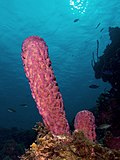Symbiodinium is a genus of dinoflagellates that encompasses the largest and most prevalent group of endosymbiotic dinoflagellates known and have photosymbiotic...
72 KB (7,408 words) - 07:32, 19 May 2024
jellyfish, and nudibranchs. Most known zooxanthellae are in the genus Symbiodinium, but some are known from the genus Amphidinium, and other taxa, as yet...
24 KB (2,742 words) - 03:57, 15 June 2024
dinoflagellate genus Symbiodinium. Some jellyfish (class Scyphozoa) in the genus Cassiopea (upside-down jellyfish) also possess Symbiodinium. Certain species...
40 KB (4,041 words) - 02:43, 30 August 2024
nutrients from photosynthetic unicellular dinoflagellates of the genus Symbiodinium that live within their tissues. These are commonly known as zooxanthellae...
110 KB (12,238 words) - 09:39, 12 October 2024
Durusdinium trenchii (redirect from Symbiodinium trenchi)
Durusdinium trenchii (formerly Symbiodinium trenchi) is an endosymbiotic dinoflagellate, a unicellular alga which commonly resides in the tissues of tropical...
4 KB (463 words) - 13:48, 15 April 2024
strategies of Symbiodinium uptake by anthozoans. Individuals can either take Symbiodinium from the maternal colony, or they can uptake new Symbiodinium from the...
13 KB (1,538 words) - 04:07, 17 September 2024
the genus Symbiodinium; however, recent genetic analysis has led to a taxonomic reorganization with several former members of Symbiodinium (previously...
6 KB (616 words) - 05:16, 6 January 2024
ectosymbiosis; when one partner lives inside the tissues of another, such as Symbiodinium within coral, it is termed endosymbiosis. The definition of symbiosis...
52 KB (5,479 words) - 18:06, 15 October 2024
are members within Symbiodiniaceae (e.g. the genus Symbiodinium). The association between Symbiodinium and reef-building corals is widely known. However...
96 KB (10,335 words) - 11:32, 9 September 2024
Unusually, these acoels harbor two genera of endosymbiotic dinoflagellates: Symbiodinium and Amphidinium; it is not typical for two different genera of dinoflagellates...
4 KB (337 words) - 12:39, 13 August 2023
Amphidinium carterae chloroplast genome, although these were not found in the Symbiodinium sp. Clade C3 chloroplast genome. Minicircle-derived transcripts can be...
5 KB (406 words) - 13:07, 11 September 2024
the genus of Neptunomonas which has been isolated from the eukaryota Symbiodinium from Puerto Rico. Parte, A.C. "Neptunomonas". LPSN. "Neptunomonas phycophila"...
2 KB (138 words) - 16:43, 17 April 2024
and particulate mucus, as well as cellular material such as expelled Symbiodinium. Organic matter could be transferred from corals to sponges by all these...
129 KB (13,202 words) - 07:56, 25 August 2024
invertebrates. These symbioses affect organisms with global impact, including Symbiodinium (corals), or Wolbachia (insects). Many insect agricultural pests and...
70 KB (7,911 words) - 18:58, 14 October 2024
require endosymbiotic algae from the genus Symbiodinium to be in a healthy condition. The loss of Symbiodinium from the host is known as coral bleaching...
92 KB (10,551 words) - 20:43, 30 September 2024
of the cerata contain nematocysts. Algal zooxanthellae of the genus Symbiodinium derived from the food of these animals continue to photosynthesise inside...
7 KB (759 words) - 12:41, 26 September 2024
symbiotic relationship with microscopic algae (dinoflagellates) of the genus Symbiodinium, commonly referred to as zooxanthellae. These organisms live within the...
163 KB (18,217 words) - 00:01, 16 October 2024
drifting past on the current. Its tissues contain symbiotic dinoflagellate Symbiodinium spp., which are photosynthetic and use sunlight to create organic carbon...
5 KB (621 words) - 20:43, 13 January 2024
(Amphidinium, Gymnodinium, Karenia, Karlodinium) Suessiales (Polarella, Symbiodinium) Noctilucea Noctilucales (Noctiluca) Syndinea Syndiniales: Amoebophryaceae...
104 KB (11,872 words) - 16:42, 14 October 2024
bivalve molluscs in the family Cardiidae, the cockles. They maintain Symbiodinium dinoflagellates as symbionts. Species in the genus Corculum are: Corculum...
2 KB (167 words) - 11:38, 7 April 2024
often contain symbiotic dinoflagellate unicellular algae of the genus Symbiodinium living inside nutritive cells. The symbionts provide food mainly in the...
8 KB (883 words) - 02:23, 4 January 2024
more unusual, including some that are colonial, amoeboid, or parasitic. Symbiodinium contains the symbiotic zooxanthellae. The non-photosynthetic members...
4 KB (369 words) - 07:11, 23 September 2024
orders within the division Chlorophyta) some dinoflagellates, notably Symbiodinium some chrysophytes some xanthophytes the diatoms the superfamily Coccoidea...
983 bytes (158 words) - 18:22, 1 September 2016
restoration Reef resilience Symbiotic algae Zooxanthellae Amphidinium Symbiodinium Other Artificial reef Aquaculture of coral Coral dermatitis Precious...
27 KB (2,599 words) - 02:43, 30 September 2024
their energy requirements from symbiotic dinoflagellates of the genus Symbiodinium (zooxanthellae), similar to many corals, anemones, and some other marine...
14 KB (1,594 words) - 12:23, 11 September 2024
(Amphidinium, Gymnodinium, Karenia, Karlodinium) Suessiales (Polarella, Symbiodinium) Noctilucea Noctilucales (Noctiluca) Syndinea Syndiniales: Amoebophryaceae...
30 KB (3,181 words) - 01:20, 24 September 2024
was characterized, revealing it to be a relative of the genus Symbiodinium. Symbiodinium is a well-studied endosymbiont of deep water invertebrates, protists...
3 KB (253 words) - 13:46, 15 April 2024
(Amphidinium, Gymnodinium, Karenia, Karlodinium) Suessiales (Polarella, Symbiodinium) Noctilucea Noctilucales (Noctiluca) Syndinea Syndiniales: Amoebophryaceae...
70 KB (7,367 words) - 19:57, 14 October 2024
Michael; Pochon, Xavier (2008-07-02). "Specificity in communities of Symbiodinium in corals from Johnston Atoll" (PDF). Marine Ecology Progress Series...
20 KB (2,215 words) - 10:23, 13 June 2024
Christian R. (March 12, 2017). "Marine Invertebrate Larvae Associated with Symbiodinium: A Mutualism from the Start?". Frontiers in Ecology and Evolution. 5...
10 KB (1,052 words) - 07:09, 12 September 2024























